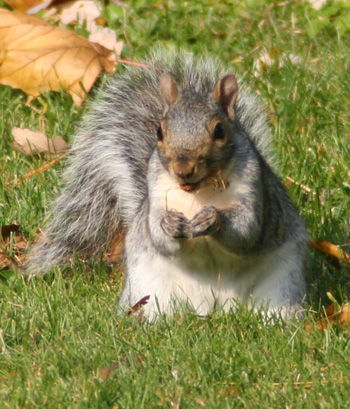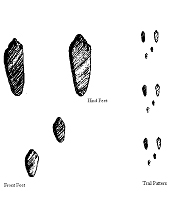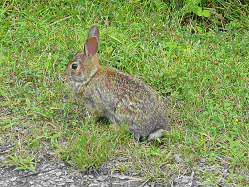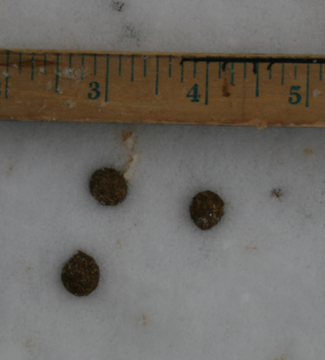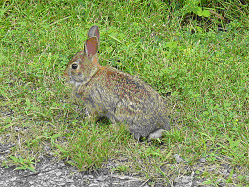Organizations: National Wild Turkey Federation – http://www.nwtf.org
Description: Turkeys are the largest of the upland game bird species. Wild turkey is a dark bird with a naked, bluish head.
The male, also called a tom, has an overall coloration that is brownish black with an iridescent sheen. His wings have black and white barring. The tom has folds of red skin, called wattles, under the chin; fleshy, wartlike caruncles on the neck; and a fingerlike snood dangling beside the bill. A 4 to 10 inch projection of feathers, called a beard, extends from the breast. Additionally, the tom has spurs on his legs. Toms measure 36 to 48 inches long and weigh 17 to 28 pounds. Wingspan on a large tom may be over four feet.
The hen is smaller and browner than the tom, and lacks head features and does not have spurs. Hens measure 26 to 34 inches and 8 to 12 pounds.
The juvenile male, called a jake, and the juvenile female, called a jenny, resemble hens by fall, although they have a duller, more mottled color. After the first year, jakes are larger than hens, and have begun to develop a beard.
Turkeys can run over 20 miles per hour and fly up to speeds of 40 miles per hour.
There are five subspecies of wild turkey in North America:
The eastern wild turkey (M. gallopavo silvestris) is the most abundant of the five subspecies. It is found throughout most of the eastern United States. Its population is increasing because of introductions, such as those in the Pacific Northwest and North Dakota. It has a copper-bronze sheen, and its tail has a chocolate-brown tip.
Merriam’s wild turkey (M. gallopavo merriami) is found in much of the western United States, from Montana to Arizona. It is the most adaptable of the five subspecies, and its numbers and range have grown due to stocking efforts. It has a purplish bronze sheen, and a buff-tipped tail.
The Rio Grande wild turkey (M. gallopavo intermedia) is an open-country bird found primarily in the south-central United States from Nebraska through Texas and into Mexico. Its range has expanded westward thanks to stocking efforts. The overall body sheen is a pale copper, and the tail has a yellowish tip.

The Florida wild turkey (M. gallopavo Osceola) is found only in Florida, and has a relatively small, stable population. It is similar in appearance to the eastern wild turkey, but has darker wings and an iridescent, greenish gold body color. It may hybridize with the eastern turkey, where the ranges of the two subspecies overlap.
Gould’s wild turkey (M. gallopavo mexicana) is found in extreme southern Arizona and New Mexico and into northern Mexico. It resembles the Merriam’s subspecies, but has a bluish green sheen and a white-tipped tail. The population is stable.
Habitat – Turkeys are birds of the big woods. An individual bird requires from a few hundred to more than a thousand acres of ground with a combination of trees for roosting, a reliable water source and an open feeding area. In spring and summer, when the birds are nesting and raising broods, they seek openings in or alongside the woods, with dense, grassy cover at least 3 feet high. In winter, they prefer more densely wooded habitat.
Birds in the East generally inhabit dense, mixed-hardwood forests and river bottomlands adjacent to agricultural lands. Birds in the West and South prefer pine and oak forests near streams. Florida birds are found in oak and pine woods, palmetto flats and cypress bottomlands.
Wild turkeys move seasonally between nesting and wintering areas, but seldom travel more than two miles. In mountainous areas, wild turkeys occupy higher elevations in spring and summer, and lower elevations in fall and winter, sometimes moving as much as forty miles between ranges.
Food – Wild turkeys eat mostly plant material, including fruits, acorns and other nuts, small grains, and the seeds, shoots and roots of grasses and various other plants. They also eat many types of insects, small amphibians and even lizards. Turkeys generally fly down from roosting trees to feed in early morning, and return to the trees in the evening.
Breeding – Toms start their breeding displays in early spring while still gathered in flocks in the wintering areas. With tail fanned, feathers fluffed and wing tips dragging, the tom struts boldly while emitting low-pitched hums. He repeats this display, coupled with the characteristic gobble call, until he attracts a hen. The most dominant toms breed with the majority of hens, continuing to display after each mated hen goes off to nest. By late spring, breeding is nearly complete and the male’s display begins to taper off. The hen becomes very secretive at nesting time, distancing herself from other hens. The nest site is usually under or near a log, bush or clump of vegetation. She scrapes a shallow depression, lines it with leaves and twigs, then lays 8 to 14 buff-colored brown-speckled eggs, which hatch in about 27 days. The young poults grow quickly and can make short flights within 8 to 10 days.
Social Interaction – Wild turkeys gather in wintering flocks that range from less than a dozen to several hundred birds. In spring, just before the mating season, this large flock divides into three sexually segregated groups: one consisting of hens, another of jakes and a third of toms. In the latter, a single tom emerges to do most of the breeding.

Because of restoration efforts by wildlife management agencies, North America has more wild turkeys now than it did during pre-settlement days.
Hunting – In states where there’s an early fall season, good turkey-hunting land has grasses and brush to support insect life, for at this time of year, both the adults and the juveniles may still be eating quantities of insects. In the spring, too, good habitat usually has some brush or swampy places. And regardless of season, there must be ponds, creeks, seeps, or swamps to provide water. Whether a hunt is in fall, winter, or spring, most of the best spots have stands of hardwoods that supply mast-acorns, beechnuts, or hazelnuts. Where these favorite foods are lacking, however, conifer seeds are heavily utilized. But bear in mind that at some times of year or in some regions, mast may be scarce or absent, and very different foods will attract turkeys: chufa grass, sumac, wild grapes, dogwood, ragweed, and all sorts of berries. Though wary, the birds will also come to farmlands for corn, sorghum, or oats.
Specific foods and feeding periods are most important during a fall hunt, when sexual attraction won’t keep the gobblers moving about or draw them as eagerly to a call that sounds like a hen’s yelp. Although turkeys feed intermittently throughout the day, and you might find them in the woods at any time, they forage most intensively for a couple of hours after dawn and before dusk, and those are the best hunting times.
A productive area must have appropriate roosts as well as foods. Turkeys prefer to spend the night in tall trees, usually more than 60 feet high and situated on a ridge or at the edge of a clearing so that no obstructions will interfere with emergency flight. In most regions they like oaks, cottonwoods, pines, spruces, and firs. In parts of the South they roost in cypresses over water (a natural moat to impede the approach of any predators). Sometimes they use the same trees for several successive nights. Even though turkeys can frequently change roosts, roosting sign is worth looking for because these birds usually stay within a fairly small area throughout the year.
Roosting sign is composed of molted feathers and quantities of droppings. A hen’s scat is looped, spiraled, or bulbous; a tom’s is longer and straighter, with a knobby twist at one end. Near roosts and in foraging areas, you may also find the big triple-toed tracks, sometimes more than six inches long. If a footprint is more than 4 1/2 inches long, a mature tom probably made it, and if the stride is over 11 1/2 inches long, it was almost certainly made by a mature tom. Also watch for scratching and digging in mast where the birds have been foraging. Another worthwhile kind of sign consists of dusting spots. These are shallow ovals, not easy to spot but sometimes marked by feathers, droppings, or tracks. Favored places for dusting are under sumacs or small trees and beside logs or burned brush. In scouting for such sign or for the birds themselves pay attention to old roadsides and trails, which the birds sometimes use not only for dusting and gritting but also for easy traveling between foraging areas.
A primary hunting method in the fall is to locate and scatter a flock (which is apt to be composed of hens and juveniles) and then call. The birds are listening for one another as they regroup, and calling will often lure one into view of your hiding spot. To locate a flock, hunters generally scout for scratching and the other kinds of sign described in mast high up on slopes, atop ridges, and on high flats.
There are more methods than you ordinarily see described in of the magazine articles that tend to emphasize the drama of calling. For example, as you scout for a flock in woods known to hold turkeys, it pays to stop occasionally, hide, and call, even if you’ve neither seen nor heard any indication of birds. This is because other hunters may already have scattered a nearby flock, in which case you have a good chance of calling in a bird.
The proper calling sounds to rally scattered turkeys in the fall are the big clucking, gobbling, and trilling. There are instructional records and tapes, as well as numerous books, to help you learn the right sounds to use both in fall and spring.
Another autumn method is to still-hunt, pretty much as you would for deer. In its pure form, this technique isn’t very productive. That is, a hunter doesn’t often get a shot at a bird spied while he slowly stalks through the woods. But if the still-hunter gets no shot during his stop-and-go progress, he can occasionally hide and call for a while, or he may find sign or even get a glimpse of a distant bird, and he can then wait on stand, either calling or just watching and waiting. Still-hunting is best in bottomlands where there’s screening brush, and on brushy slopes. When working the slopes, move to the summits every few hundred yards to scan the opposite hillsides. Good ‘Stands are generally near the edges of fields or clearings, or overlooking small, openly wooded valleys, or near old roads, trails, or burns.
It pays to scout a turkey area thoroughly, then go on stand near a roost well before sunrise. The birds may start calling while it’s still dark, and they’ll probably begin moving at first light. If you don’t take a turkey from such a stand in the early morning, you can try again very late in the afternoon-just in case a turkey goes to roost early.
You must be concealed when you go on stand. You’ll probably find plenty of natural blinds-logs, boulders, blowdowns, clumps of brush, etc. but it’s not a bad idea to pack along a roll of camouflage netting to improve such blinds. Sometimes, too, you can enhance a natural blind with fallen branches, brush, and twigs.
Camouflage apparel is also a great help. Most hunters wear a camouflage-pattern jacket, pants, and hat. Some wear a camouflage face-net or mask, or blacken their faces and hands with burnt cork, or apply camouflage grease paint, which is available at many archery-equipment outlets and some general sporting-goods stores. A few hunters go further, wearing camouflage gloves and even camouflage-pattern shoes or boots.
The basic types of store-bought calls are boxes with hinged handles, boxes with separate strikers, tubes, slates, box or wingbone suction calls, aluminum-groove calls and diaphragm yelpers. Some are more popular (or traditional) than others in various regions. The diaphragm type takes some practice to make it sound right, but it has the advantage of leaving both your hands free, and it can be quite realistic. It’s a vibration device, worked between your tongue and the roof of your mouth.
In the spring hunting season, sexually receptive hens call to any available males by uttering rather plaintive yelps, which sound something like keowk, keowk. This is the most basic and frequently effective call. It isn’t the only sound you need. When flying from a roost, turkeys sometimes yelp more softly, and they often cluck and trill while feeding. An imitation of these calls isn’t important (though it might attract a gobbler’s attention) but once in a while such sounds may help you locate birds. More important is the gobbling and yodeling of the males-sounds used to warn other males away and respond to calling females. The basic gobbling sound might be described as a high, throaty gl-obble-obble-obble, sometimes preceded by or combined with a more yodel- grrrrddle sound.
Calling is usually best when there’s little or no breeze. When rustling wind can cover the sound of approaching predators, turkeys remain still and hidden. On calm days they’re active, and their gobbling can sometimes be heard at a distance of more than half a mile.
